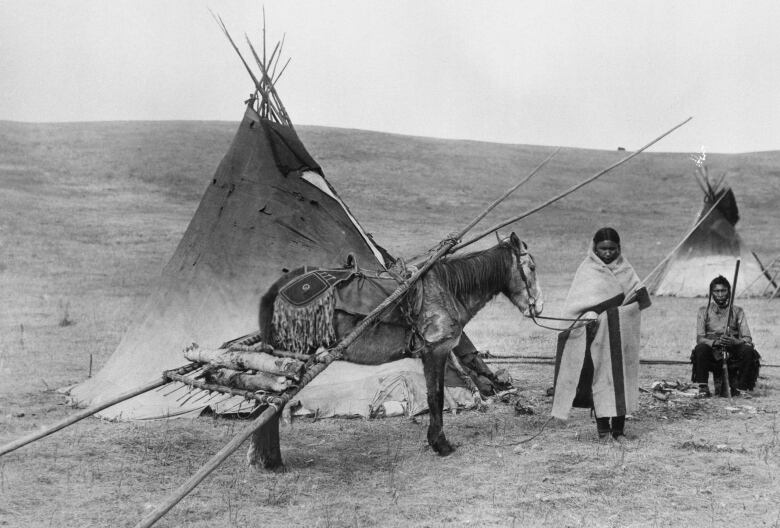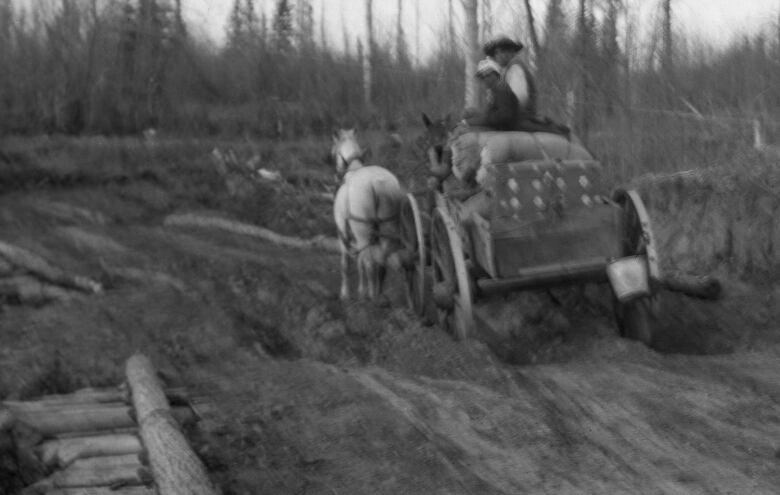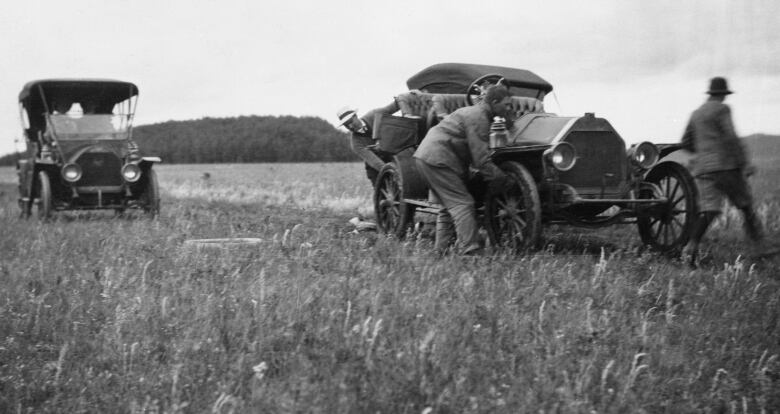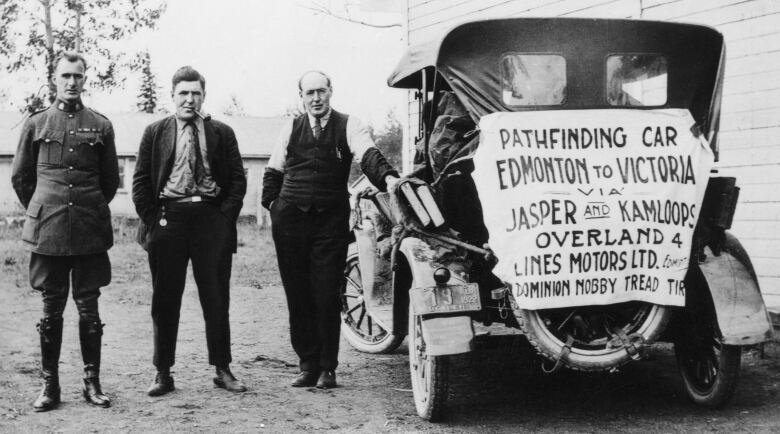How Alberta built enough roads to reach the moon
What paved the way for a province's transformation from rural backwater to economic powerhouse
This article was originally published on Oct. 1.
Split up all the roadsin Alberta, lay them end to end, and you'd have more than enough to reach the moon.
This lunar road would be onlya single lane wide, granted, and most of it would be gravel, but this gives you a sense of just how many roads criss-crossour vast province.
From the Peace Country's sleepiest range road to Calgary's bustling Deerfoot Trail, add it all upand nearly a quarter of Canada's total roadway is in Alberta some 473,000 kilometres of single-lane equivalent, in total. There are nearly as many roads here as in all of Ontario, which has nearly twice our land mass and more than three times our population.
It's no surprise, then, that driving is deeply ingrained in Albertan culture.
How did this come to be?
A lot of it has to do with our geography. Alberta is spread out, with lots of people to connect over large distances, both east-west and north-south. It helps, too, that the terrain is relatively flat and easy to build on.You can see how that's influenced road development in the map below.

We're also a well-off province. Various oil booms over the decades have made it easier for governments to build highways and for Albertans to buy cars. In 2004, we became the first province to record more registered vehicles than people.
But the origins of Alberta's love affair with roads can be traced back much further.
Highways that now carry millions of cars each year follow routes that were established centuries ago. Faint paths worn into the soil grew widerover time and multiplied. Paths became roads. Cars replaced horses. Voters demanded more reliable highways, and governments obliged.
These changes did more than alter the landscape. They had a profound effect on the way people lived. The ever-expanding spiderweb of roadways made far-away places grow closer. Disparate communities became more connected. Society grew tighter.
Alberta, as we know it, was born.
A land before roads
Three hundred years ago,there was nothing resembling a road in the untamed territory that would eventually become this province. From the Rockies' peaksto the rolling foothills, the sprawling grasslands and vast forests, the land wasraw.
In the early 1700s, you would have been hard-pressed to even find a dirt path, says historian Hugh Dempsey.
The former curator of Calgary'sGlenbowMuseum has documented Alberta's history like no one else, conducting extended interviews with Indigenous elders about what life was like for their ancestors, the original inhabitants of this land.
"Prior to the 1740s and so on, there were no horses," Dempsey says. "So they would be moving from place to place on no established route, on foot. And the distances they travelled, of course, would be quite limited."
It wasn't until the first fur traders arrived in the 1790s that major, fixed trails started to be carved into the landscape.
At that time, canoes were still the fastest way to get around, so traders set up camps along the various rivers and lakes. From Fort Chipewyan to Rocky Mountain House, trading posts started to dot the landscape. These permanent settlements marked a major change in how people lived and travelled on the land.
For centuries prior, the Indigenous inhabitants were nomads. They followed the buffalo. Their exact travel routes varied from year to year, depending on the weather and wherever the easiest river crossings happened to be.
But now, they started carrying furs from hunting grounds to the same trading posts season after season. They dragged their loads with travois, a type of sled made up of two long poles lashed to the sides of a horse (or, sometimes, a dog). They left their marks on the land.

"They didn't travel in a single line," says Dempsey. "They would be maybe three or four travois wide. So it would be a path, rather than a trail."
Smaller paths also started to sprout between the trading posts. Even more emerged in the 1860s with the arrival of missionaries, who travelled the land in search of converts to Christianity and set up their own outposts, which in turn connected to the trading areas.
The way humans existed on the land had fundamentally shifted. Flowing, nomadic lifestyles gave way to a world of fixed placesconnected by fixed routes.
It would be hard to describe these early paths as roads, aswe understand them today. They were bumpy and unreliable. Wayfinding was hard. The transportation networkcontinued to grow but in a haphazard way. The system lacked planning, organization and funding.
But that was about to change.
Government gets involved
Confederation came in 1867, but it took a few more years for the vast tracts of land west ofLake Superior to become a part of the new country called Canada.
The Hudson's Bay Company had long claimed control of this region and, in 1870, sold it to the federal government. This became the North-West Territories, save for a small rectangle around Winnipeg that became Manitoba.
The government set about settling the new territory.
The North West Mounted Police were dispatched to enforce federal laws. Engineers explored the rugged Rocky Mountains and drew up routes for a railroad to the Pacific. And homesteaders moved to the plains, by the tens of thousands.
With these new arrivals came new travel routes. But they didn't reinvent the wheel. Wherever possible, they followed in the footsteps of those who went before them.
"The routes that they took were logical," Dempsey says of the people who established those earliestpaths.
"And so the logic kind of carried over to the settlement period, when many of these same routes were used."
Over time, the routes become moreestablished and more worn.
Imagine a dirt road set in soft prairie soil. Now imagine a hundred horses a day plodding along in the rain, some dragging carriages through the mud. Now imagine the horse traffic doubles. And then doubles again.
Conditions like these are what travellers faced as the 20th century arrived.

There was"much complaint" about the poor condition of roads, according to an archived government report. The situationwas especially bad near Edmonton where, during rainy periods in 1899 and 1900, "it was not possible to travel on some of the more important highways, even with a light buggy."
"So long as we have earth roads we must expect bad roads during wet seasons," the report says.
Anything other than earth roads would be impossible for "many years to come," the report adds, meaning "goodroads" remained"one of the most troublesome problems" in the new territory. Residents would have to settle for "passable roads" in the meantime.
But the demand for roads was about to grow even further, with the arrival of a new type of vehicle that could travel much faster,provided it had a relatively smooth surface to travel on.
The age of the automobile was about to dawn.
The rise and influence of auto clubs
In 1901, a rancher named Billy Cochranebrought a new contraption north from the United States to his property near Cayley, a small hamlet in southern Alberta located about halfway between High River and Nanton.
His horseless buggy, known as a Locomobile, burned liquid fuel to heat water stored in a tank, which powered a small steam engine. A full tank of water could take him about 30 kilometres.

These early cars were notoriously unreliable and prone to breakdowns, butrelatively affordable. Some models cost as little as $600 US (about $18,000in today's dollars) and the Locomobile became the best-selling car in the United States in 1901. In the next few years, the manufacturers gave up onsteamand switched to even more powerful combustion engines.
It didn't take long for the motoring trend to catch on and for conflicts to arise.
When Alberta became a province in 1905, it was home to only about 40 automobiles, but concerns were already being raised about the fast-moving vehicles.The newly formed provincial government introducedspeed limitsas one of its first pieces of legislation.
Under the new law, cars were to travel no faster than 20 miles per hour (32 km/h) in rural areas and 10 miles per hour (16 km/h) in cities. Drivers were also required to stop immediately if their vehicle startled a horse, and then wait for the animal to move on before proceeding.
The federal government, meanwhile, banned cars within Banff National Park.
The sudden onslaught of regulation,along with the introduction of licensing fees, prompted some motorists to blow a gasket. Many organized into clubs and lobbied the government for drivers' rights, as well as for better, safer and more ways to travel.
The result was a "huge boom in roads," says NinaReddingwith the Alberta Motor Association. (The AMA, itself, formed in 1926 through the amalgamation of several auto clubs.)
In their earliest days, Redding says, club members would take it upon themselves to build and maintain rough "roads" that probably wouldn't be described as such today. These were often made of sand or gumbo clay.
"Gumbo roads were impassable when they were wet but the sand roads were impassable when they were dry," she says. "So it made for really difficult driving conditions, depending on the weather."
The clubs also put up signs to help drivers find their way through the often confusing network of routes that meandered through variable terrain.
"The signs helped distinguish roads in their area from sheep and cattle trails," Redding says.

The Calgary Automobile Club, meanwhile, had been lobbying to have the Banff driving ban lifted and, in 1911, the federal government agreed to allow automobiles in the park.
The following year, Redding says, club membershelped improve sections ofthe road between Calgary and Banff to the point that drivers could be "skipping along at 25 to 30 miles per hour (40 to 48 km/h), which would have been huge back then."
In the 1920s, the Edmonton Automobile and Good Roads Association campaigned for a more reliable route to Jasper National Park.
Roads within the park were relatively good at that time,Reddingsays, but getting to the tourist destination remained a risky affair. Drivers had two choices:follow a muddy path where theywere likely to get stuck, or bounce along the wooden ties of an abandoned rail line where the tracks had been removed for scrap iron during the First World War.
To build public support, auto club members decked out their vehicles with signs that read "Build a Jasper Highway" and paraded them through the city. An adventurous duo also teamed up to make the first automobile trip from Edmonton to Victoria, via Jasper's Yellowhead Pass, to show how difficult the existing route was.

"Often the pair had to stop and build bridges or dig themselves out of boggy areas," reads a description of the trip from the Glenbow Archives.
The various lobbying efforts succeeded. Improvements soon followed and the Jasper-Edmonton road opened in 1928. This was a precursor to the YellowheadHighway, which would later stretch all the way east to Winnipeg and all the way west to Haida Gwaii.
"The early owners of automobiles were so innovative and were instrumental in forming the roads in Alberta and really making their voices heard to the government," Redding says.
And those voices were ever growing.
Driving goes mainstream
In 1910, about 400 Albertans owned a car. By 1920, there were more than 38,000 registered vehicles in the province.
In 1922, the Alberta government agreedto share road-building costs with municipalities. To help pay for all that construction, it also became the first province to introduce a gasoline tax, set at two cents per gallon or about six cents per litre, in today's terms.
The higher cost of gas didn't slow down the motoring trend. By 1929, annual revenues from the fuel tax had increased tenfold.
When the Great Depression struck, car ownership declined but road construction continued. Labourers living in governmentwork camps built new highways or gravelled and graded old ones.
"Work relief programs improved hundreds of kilometres of highway," Redding says.
As the Depression gave way to the Second World War, things changed. Road construction slowed as resources were redirected to the war effort.
But road-building picked up again in the late 1940s, aided by the discoveryof oil at Leduc in 1947. Over the ensuing decade, the increasingly flush provincial governmentspent accordingly on its transportation network.
The federal government started investing more, as well, pitching in to construct the Mackenzie Highway, a nearly 600-kilometre route between Grimshaw, Alta., and Hay River, N.W.T., that was completed in 1949.
Around this time, Ottawa also announced plans for an ambitious east-west route that would connect virtually everybody in the country with nearly 8,000 kilometres of continuous roadway.
The Trans-Canada Highway "officially" opened in 1962, although thousands of kilometres remained unpaved.
The grand-opening ceremony was amomentousaffair, with Prime Minister John Diefenbaker extolling the Trans-Canada as a nation-building achievement.
"This highway, may it serve to bring Canadians closer together," he said.
"May it bring to all Canadians a renewed determination to individually do their part to make this nation greater and greater still, worthy of the destiny that the fathers of Confederation had expected."
The road, in other words, wasn't just a connection between Canada's east and west, but between its past and its future. It was a thread to stitch together the fabric of a society that had been imagined a century earlier.
Diefenbaker gave that speech more than 50 years ago.
And many more roads were yet to come especially in Alberta.
The modern era
The late 1960sand early 1970s saw an explosion in the number of people driving and the distances they could drive. Gasoline sales skyrocketed. Annual revenues from Alberta's fuel tax doubled in a span of six years.
Since it was adopted back in 1922, this levy was also known as the "road-use tax" because the proceeds were meant to build more streets and highways. But, in 1978, the tax was abolished, by popular demand.
Road construction continued, of course. The government just paid for it by other means, which wasn't a problem at the time. In the late1970s, energy prices were sky high and oil and gas royalties made up an astounding 70 to 77 per cent of provincialrevenues.
The oil glut of the 1980s changed all that. Prices crashed and Alberta suddenly found itself strapped for cash. In 1987, the province started taxing gasoline and diesel again.
The revenue was badly needed, but the idea that road constructionhinged on the fuel tax had already been erased. By now, roads and highways had become a basic function of government.Good times or bad,Albertansnow expect good roads, not just "passable" ones, like a century earlier.
And, for the most part, we get them.
Calgary'sDeerfootTrail was completed amid the recession of the early1980s, with a price tag that stretchedinto the hundreds of millions of dollars. The six-lane freeway has seen numerous upgrades since then and today its busiest sections carry more than 170,000 vehicles per day.
Anthony Henday Drive in Edmonton fully opened in2016, after decades of staged construction and a total cost that topped $4 billion. The ring road now provides nearly 80 kilometres of free-flow traffic around the city.
Over the past decade, in general, Alberta has witnessed an unparalleled improvement in both thequantity and quality of its roads. The value of our province'sroad and highway infrastructure has more than doubled since 2009. That rate of growth is nearly triple the rest of the country.
All that fresh concrete and asphalt marks the latest phase in what's been a massive transformation.
From backwater to economic engine
In just over a century, Alberta has gone from a chaotic frontier to an organized network of interconnected communities, while its place in the nation has been transformed from rural backwater to economic powerhouse.
None of this would have been possible without the roads that carry us and our goods, daily, to wherever we needor want to go.
The speed and scale of our modern transportation system would have been hard to imagine for Blackfoot hunters dragging their furs behind horses, or early motorists pushing their cars through soft gumbo clay. And while our daily commutes bear little resemblance to those of our forebears, we still travel many of the same routes.
"They're a real, indelible mark of history," says JesseSalus, a Calgary resident with aparticular passion for roads and how they shape our lives.
Salusis one of those people who started out as an amateur but, through endless curiosity and sheer passion, became an expert. For most of the past decade, he's combed through archives, government records and old newspapers to uncover the history of roads in southern Alberta and detail his findings onapopular website.
He admits he's a bitobsessiveabout all this. When he launched his website as a hobby in 2010, he didn't expect much attention, apart from other, self-described road geeks. He says he would have been thrilled to have 100 visitors. He's since amassed 366,000.
The broad appeal surprised him, at first. But he soon recognized why so many people share his fascination.
Alberta's roads have created the place we now call home. But they also offer a glimpse of how that home came to be. Whether we realize it or not, it's right there beneath our feet.
"We maybe don't think about it that often but we fundamentally understand how vitally important they are to everything we do," says Salus.
"Those connections whether it's a road or a pathway or anything else they are important to who we are."
Calgary: The Road Aheadis CBC Calgary's special focus on our city as it passes through the crucible of the downturn: the challenges we face, and the possible solutions as we explore what kind of Calgary we want to create. This story is part of a sub-series on roads and how they shape our lives. Have an idea for a future story? Email us: calgarytheroadahead@cbc.ca
More stories from the Road Ahead series:
Corrections
- An earlier version of this story contained an incorrect calculation of the cost of the 1922 gas tax in 2018 dollars.Oct 03, 2018 5:39 PM MT
















_(720p).jpg)


 OFFICIAL HD MUSIC VIDEO.jpg)
.jpg)



























































































